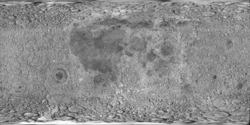O'Day (cráter)
| O'Day Cráter lunar | ||
|---|---|---|
 Imagen de la misión Lunar Orbiter 2 | ||
| Coordenadas | 30°25′S 157°17′E / -30.42, 157.29 | |
| Diámetro | 71 km | |
| Profundidad | 2761 m | |
| Colongitud | 203° al amanecer | |
| Epónimo | Marcus O'Day | |
|
Localización sobre el mapa lunar | ||

O'Day es un prominente cráter de impacto perteneciente a la cara oculta de la Luna. El borde del noroeste ha sufrido la intrusión del Mare Ingenii, por lo que el brocal es más bajo en ese lado. Al noroeste se halla el par de cráteres formado por Holetschek y Sierpinski. Al suroeste de O'Day se encuentra el cráter Seidel. Se nombra en honor del físico estadounidense Marcus O'Day.
 |
El borde del cráter sigue siendo afilado, con una pared interna aterrazada, especialmente en la mitad noroeste del mar lunar. Un pequeño cráter atraviesa el borde sur, con otro impacto de tamaño reducido bajo el borde, entre el cráter y el mare. El suelo es áspero e irregular, con un doble pico en el punto medio.
Debido a sus prominentes rayos, O'Day se asigna como parte del Período Copernicano.[1]
Cráteres satélite
[editar]Por convención estos elementos son identificados en los mapas lunares poniendo la letra en el lado del punto medio del cráter que está más cercano a O'Day.
 |
|
Véase también
[editar]Referencias
[editar]- ↑ The geologic history of the Moon, 1987, Wilhelms, Don E.; with sections by McCauley, John F.; Trask, Newell J. USGS Professional Paper: 1348. Plate 11: Copernican System (online)
- (WGPSN), IAU Working Group for Planetary System Nomenclature (13 de febrero de 2013). «Gazetteer of Planetary Nomenclature. 1:1 Million-Scale Maps of the Moon» (en inglés). UAI / USGS. Consultado el 6 de abril de 2016.
- Andersson, L. E.; Whitaker, E. A., (1982). NASA Catalogue of Lunar Nomenclature (en inglés). NASA RP-1097.
- Blue, Jennifer (25 de julio de 2007). «Gazetteer of Planetary Nomenclature» (en inglés). USGS. Consultado el 2 de enero de 2012.
- Bussey, B.; Spudis, P. (2004). The Clementine Atlas of the Moon (en inglés). Nueva York: Cambridge University Press. ISBN 0-521-81528-2.
- Cocks, Elijah E.; Cocks, Josiah C. (1995). Who's Who on the Moon: A Biographical Dictionary of Lunar Nomenclature (en inglés). Tudor Publishers. ISBN 0-936389-27-3.
- McDowell, Jonathan (15 de julio de 2007). «Lunar Nomenclature» (en inglés). Jonathan's Space Report. Consultado el 2 de enero de 2012.
- Menzel, D. H.; Minnaert, M.; Levin, B.; Dollfus, A.; Bell, B. (1971). «Report on Lunar Nomenclature by The Working Group of Commission 17 of the IAU». Space Science Reviews (en inglés) 12: 136.
- Moore, Patrick (2001). On the Moon (en inglés). Sterling Publishing Co. ISBN 0-304-35469-4.
- Price, Fred W. (1988). The Moon Observer's Handbook (en inglés). Cambridge University Press. ISBN 0521335000.
- Rükl, Antonín (1990). Atlas of the Moon (en inglés). Kalmbach Books. ISBN 0-913135-17-8.
- Webb, Rev. T. W. (1962). Celestial Objects for Common Telescopes, 6ª edición revisada (en inglés). Dover. ISBN 0-486-20917-2.
- Whitaker, Ewen A. (2003). Mapping and Naming the Moon (en inglés). Cambridge University Press. 978-0-521-54414-6.
- Wlasuk, Peter T. (2000). Observing the Moon (en inglés). Springer. ISBN 1-85233-193-3.
- «Lunar Impact Crater Database» (en inglés). Lunar and Planetary Institute (USRA). Consultado el 12 de septiembre de 2017.
Enlaces externos
[editar]- Referencia UAI del CRÁTER
- LPI Digital Lunar Orbiter Photographic Atlas of the Moon
- Mapa LROC
- Mapa Lunar 103, mostrando O'Day y alrededores (Mapas regionales en el Lunar and Planetary Institute).
- The-moon.wikispaces.com: O'Day Archivado el 31 de mayo de 2018 en Wayback Machine.
 Wikimedia Commons alberga una categoría multimedia sobre O'Day.
Wikimedia Commons alberga una categoría multimedia sobre O'Day.

